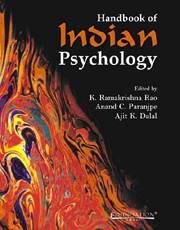Book contents
- Frontmatter
- Contents
- Contributing Authors
- Preface
- 01 Prologue: Introducing Indian Psychology
- 02 Indian Thought and Tradition: A Psychohistorical Perspective
- PART I SYSTEMS AND SCHOOLS
- PART II TOPICS AND THEMES
- 16 Indian Theories of Perception: An Inter-School Dialogue from Buddhist Perspective
- 17 Indian Psychology of Motivation
- 18 Personality in Indian Psychology
- 19 “Giving” as a Theme in the Indian Psychology of Values
- 20 The Making of a Creative Poet: Insights from Indian Aestheticians
- 21 Anchoring Cognition, Emotion and Behaviour in Desire: A Model from the Bhagavad-Gītā
- 22 Consciousness
- 23 J. Krishnamurti: Freedom from Knowledge
- PART III APPLICATIONS AND IMPLICATIONS
- Pronunciation and Transliteration of Sanskrit Alphabet
- Glossary
- Index
17 - Indian Psychology of Motivation
from PART II - TOPICS AND THEMES
Published online by Cambridge University Press: 26 October 2011
- Frontmatter
- Contents
- Contributing Authors
- Preface
- 01 Prologue: Introducing Indian Psychology
- 02 Indian Thought and Tradition: A Psychohistorical Perspective
- PART I SYSTEMS AND SCHOOLS
- PART II TOPICS AND THEMES
- 16 Indian Theories of Perception: An Inter-School Dialogue from Buddhist Perspective
- 17 Indian Psychology of Motivation
- 18 Personality in Indian Psychology
- 19 “Giving” as a Theme in the Indian Psychology of Values
- 20 The Making of a Creative Poet: Insights from Indian Aestheticians
- 21 Anchoring Cognition, Emotion and Behaviour in Desire: A Model from the Bhagavad-Gītā
- 22 Consciousness
- 23 J. Krishnamurti: Freedom from Knowledge
- PART III APPLICATIONS AND IMPLICATIONS
- Pronunciation and Transliteration of Sanskrit Alphabet
- Glossary
- Index
Summary
Ancient Indian psychology maintains that analysis of actions provides clues to the individual's motives, and the knowledge of motives, in turn, makes it possible to forecast his behaviour under different circumstances. By motives were implied three relatively independent types of psychological phenomena, closely interrelated, but not completely identical. They represent, firstly, motives as inducements to activity directed towards satisfaction of an individual's needs that indicate to the source of the individual's activeness in general and the needs stirring him to activity in particular. Secondly, motives point to the objects of activeness and explain the individual's preference for a particular type of behaviour. In this sense motives coincide with reasons for a particular line of behaviour chosen by the subject and, in the aggregate, constitute what is known in psychology as personality orientation. Thirdly, motives emerge as means of the individual's self-regulation i.e., as an instrument of control by the individual of his own behaviour and activity.
The volitional act (action) represents a unity of all the three types or aspects of its motivation: the source of activeness, its directionality and means of self-regulation. Motives arising from needs cause the individual to perform some actions and abstain from others. Depending on the degree to which the individual is aware of his motives, they can be divided into drives and desires. A drive or an instinctive impulse is a motive for activity which represents an undifferentiated need the subject is not fully aware of. For example, an attraction towards a certain person causes an individual to experience pleasure at the sight or sound of that person and ‘drives’ him to seek, often involuntarily, meetings with the person.
- Type
- Chapter
- Information
- Handbook of Indian Psychology , pp. 336 - 347Publisher: Foundation BooksPrint publication year: 2008
- 1
- Cited by



